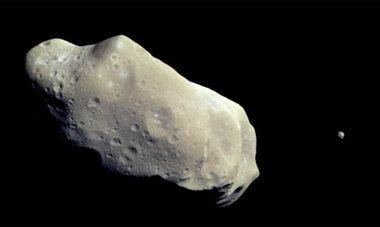Discovered by LINEAR (704) Aphelion 1.1044 AU (165.22 Gm) Discovered 22 June 2011 Argument of perihelion 4.68° | Discovery date 2011 June 22 Observation arc 967 days (2.65 yr) Semi-major axis 1.0602 AU (158.60 Gm) Inclination 2.5837° Mean anomaly 9.1059° | |
 | ||
Similar Solar System, (308635) 2005 YU55, 2008 TC3, 2004 FH, (29075) 1950 DA | ||
2011 MD is an Apollo asteroid that passed relatively close to Earth's surface — at a distance of about 12,000 kilometers (7,500 mi), roughly the diameter of the Earth — at around 17:00 UTC (13:00 EDT) on June 27, 2011. Although the object was initially believed to be space junk, subsequent observations confirmed that it is an asteroid.
Contents
A few hours before the asteroid's nearest approach in 2011, it appeared close to the Sun, so observations were possible for only a brief period. Backyard astronomers were able to observe it with telescopes from Australia, southern Africa, and the Americas.
Asteroid 2011 md june 2011
Overview
The asteroid was discovered on June 22, 2011, by the Lincoln Near-Earth Asteroid Research (LINEAR) pair of robotic telescopes in New Mexico, and according to original rough estimates, the asteroid's length was between 10 and 45 meters (30 and 150 ft). However, according to the more recent absolute magnitude (H) measurement of 28.1 and its albedo of 0.3, the asteroid is closer to 6 meters in diameter.
Emily Baldwin of Astronomy Now said that there was no threat of collision, and should the asteroid enter Earth's atmosphere, it would "mostly burn up in a brilliant fireball, possibly scattering a few meteorites", causing no likely harm to life or property on the ground.
The June 27, 2011 close approach to Earth increased the orbital period of 2011 MD from 380 days to 396 days. During close approach the asteroid passed Earth at a relative speed of 6.7 km/s with a geocentric eccentricity of 1.1.
2011 MD was observed by the Spitzer Space Telescope in February 2014 and estimated to be 6 meters (20 ft) in diameter. The asteroid is a porous rubble pile with a density similar to water. On June 19, 2014, NASA reported that asteroid 2011 MD was a prime candidate for capture by the Asteroid Redirect Mission (ARM) in the early 2020s.
